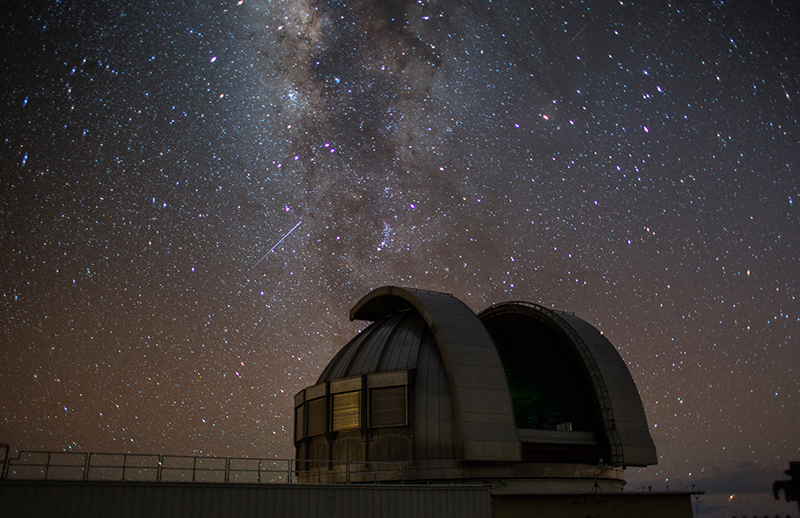
07 Feb Canary Islands, a paradise for astronomers too
When we look up at the sky from our innocent perspective, everything seems to revolve around us. This gives us the impression that we are at the center of creation. But, more than four centuries ago, something happened that redefined our place in the universe and shook society to its core.
“Telescopes allow us to travel back in time because, in astronomy, the farther we look, the deeper we delve into the past.”
In 1608, Hans Lippershey patented an instrument called a kijker, or “viewer.” Lippershey was a German national who lived in Holland, but his invention was patented in Belgium.
So there are several countries that lay claim to the honor of his authorship. Nevertheless, as Darwin said: “In science, the credit goes to the man who convinces the world, not the man to whom the idea first occurs.” This explains why the glory ultimately went to Italy, thanks to Galileo Galilei.
In 1609, the telescope became an essential instrument for studying the Universe.
Over four centuries later, there are giant telescopes installed in different parts of the world. Their construction required colossal investments. Because of this, most of these telescopes were financed or are currently shared by various nations.
The Canary Islands: Starlight Reserve.
“The Canary Islands is one of the most privileged spots for astronomical observation”, as the photojournalist Pepo Paz Saz put it in his book Los mejores destinos para observar los cielos de España (“The Best Places to Observe the Sky in Spain”). Author Peter Kujawinski made a similar affirmation in his New York Times article “Where Will Science Take Us? To the Stars”.
The Canary Islands are widely recognized as an excellent natural heritage. This is thanks to the quality of the skies above and the climatic and geographic conditions, which are perfect for astrophysical research.
In fact, the islands offer such ideal conditions that its observatories welcome over 2,000 astronomers a year. Thousands of photojournalists, photographers, amateur astronomers, and astronomy buffs also travel to the observatories each year to get a closer look at the universe.
The Canary Islands Institute of Astrophysics, IAC for its initials in Spanish, is certified by UNESCO as a “Starlight Reserve.” The IAC founded the Starlight Foundation, whose mission is to protect the starry sky, advance the study of astronomy, and promote, coordinate, and manage the Starlight movement.
IAC: EUROPEAN NORTHERN OBSERVATORY
The Canary Islands Institute of Astrophysics and its observatories –the Teide Observatory in Tenerife (OT) and the Roque de los Muchachos Observatory (ORM) in La Palma– are known collectively as the European Northern Observatory. Together, they hold the largest collection of telescopes in the northern hemisphere. The facilities are the property of national and international consortia.
Among other things, researchers working at these Observatories discovered the first black hole in our galaxy’s halo, the cosmosomes in cosmic microwave background radiation, and the first brown dwarf in the Pleiades.
The European Northern Observatory (ENO) is ideal for both night and solar physical observation, which also makes it appealing for high-energy astrophysics.
Gregor: The Biggest Solar Telescope in Europe
Its geographic location, between the eastern and western solar observatories, combined with the excellent astronomical quality and transparency of the sky above, make the Teide Observatory the ideal strategic spot from which to study to Sun. This made it the ideal place to install Gregor, the biggest solar telescope in Europe.
GTC: The Biggest Optical Telescope in the World
The Roque de los Muchachos Observatory is home to the Gran Telescopio de Canarias (GRANTECAN-GTC). The GTC is considered one of the most advanced telescopes in the world. It has the widest optical-infrared range of any other telescope and features a segmented primary mirror measuring 10.4 meters in diameter.
With its state-of-the-art technology, the GTC has helped answer a great many questions about the creation of the known Universe because, much like a time machine, the GTC has the capacity to “see” the most distant objects in our Universe. The light these objects emit originated some 15 billion years ago.
All this establishes the Canary Islands as a paradise for any self-respecting astronomer. It’s a paradise that allows us to look the universe in the eyes and delve into its past, studying the secrets of the stars as we continue to ponder the reason for our existence.

